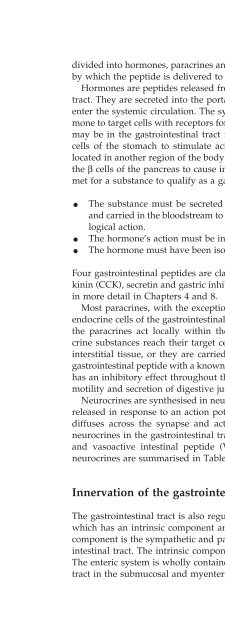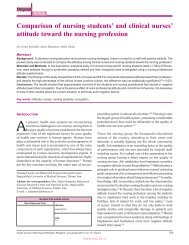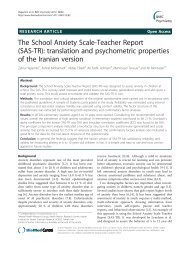Gastrointestinal Nursing.pdf
Gastrointestinal Nursing.pdf
Gastrointestinal Nursing.pdf
You also want an ePaper? Increase the reach of your titles
YUMPU automatically turns print PDFs into web optimized ePapers that Google loves.
An Overview of the <strong>Gastrointestinal</strong> Tract 17divided into hormones, paracrines and neurocrines, depending on the methodby which the peptide is delivered to its target site.Hormones are peptides released from endocrine cells of the gastrointestinaltract. They are secreted into the portal circulation, pass through the liver andenter the systemic circulation. The systemic circulation then delivers the hormoneto target cells with receptors for that specific hormone. These target cellsmay be in the gastrointestinal tract itself (e.g. gastrin acts upon the parietalcells of the stomach to stimulate acid secretion), or the target cells may belocated in another region of the body (e.g. gastric inhibitory peptide acts uponthe β cells of the pancreas to cause insulin secretion). Several criteria must bemet for a substance to qualify as a gastrointestinal hormone:• The substance must be secreted in response to a physiological stimulusand carried in the bloodstream to a distant site, where it produces a physiologicalaction.• The hormone’s action must be independent of any neural activity.• The hormone must have been isolated, purified and chemically identified.Four gastrointestinal peptides are classified as hormones: gastrin, cholecystokinin(CCK), secretin and gastric inhibitory peptide (GIP). These are discussedin more detail in Chapters 4 and 8.Most paracrines, with the exception of histamine, are peptides secreted byendocrine cells of the gastrointestinal tract. In contrast to hormones, however,the paracrines act locally within the same tissue that secretes them. Paracrinesubstances reach their target cells by diffusing short distances throughinterstitial tissue, or they are carried short distances in capillaries. The onlygastrointestinal peptide with a known paracrine function is somatostatin, whichhas an inhibitory effect throughout the gastrointestinal tract in that it reducesmotility and secretion of digestive juices.Neurocrines are synthesised in neurones of the gastrointestinal tract and arereleased in response to an action potential. Following release, the neurocrinediffuses across the synapse and acts upon its target cell. There are manyneurocrines in the gastrointestinal tract including acetylcholine, noradrenalinand vasoactive intestinal peptide (VIP). The sources and actions of theseneurocrines are summarised in Table 2.1.Innervation of the gastrointestinal tractThe gastrointestinal tract is also regulated by the autonomic nervous system,which has an intrinsic component and an extrinsic component. The extrinsiccomponent is the sympathetic and parasympathetic innervation of the gastrointestinaltract. The intrinsic component is called the enteric nervous system.The enteric system is wholly contained within the wall of the gastrointestinaltract in the submucosal and myenteric plexuses.















